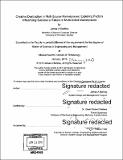Creative destruction in multi-source marketplaces : exploring factors influencing success or failure in multi-sided marketplaces
Author(s)
Barkley, James A., E.M. Massachusetts Institute of Technology
DownloadFull printable version (20.58Mb)
Other Contributors
Massachusetts Institute of Technology. Engineering Systems Division.
Advisor
David Robert Wallace.
Terms of use
Metadata
Show full item recordAbstract
This work explores key factors that influence the patterns of creative destruction in Multi-Sided Platforms (MSPs) with the intent to determine which controls are likely to lead to particular patterns of success or failure of such a platform in the marketplace. This work builds on previous research in crowd-sourcing and multi-sided marketplaces by examining previously' discovered factors in the marketplace to understand their impacts, especially as they act as determinants to an MSP's success or failure. Eleven key factors of business strategy, technology strategy, and awareness-building were identified through an extensive literature review; dynamic simulations and uncertainty modeling were used to assess the level of influence of these factors. Simulation experiments for Facebook and Twitter were conducted and compared to historical adoption and financial data of both platforms, along with a hypothetical case study and a sensitivity analysis of all variables. Implications for future research are that more study of user motivations for value creation and their impact is needed. Furthermore, the macro-economic dynamics add complexity, but are critical to understanding creative destruction. Implications for business leaders are that special attention should be given to anything that can enhance or inhibit Contact Rate and Adoption Fraction, and that when assessing tradeoffs, entrepreneurs should remember this fundamental tenet: enhance adoption incentives and limit adoption inhibitors. The results of this research suggest that indirect network effects behave as amplifying or inhibiting forces acting on direct network-effect forces, and can be controlled through policy, or in some cases managed as constraints. This study finds that the key elements to focus on for understanding, forecasting, or optimizing a Multi-Sided Platform in the wild are: Coopetition, Content Per User, Awareness Effectivity, Revenue Per User, Cost Per User, Market Competitiveness, and Content Quality.
Description
Thesis: S.M. in Engineering and Management, Massachusetts Institute of Technology, School of Engineering, System Design and Management Program, Engineering and Management Program, February 2016. Cataloged from PDF version of thesis. "January 2015." Includes bibliographical references (pages 102-107).
Date issued
2016Department
Massachusetts Institute of Technology. Engineering and Management Program; System Design and Management Program.Publisher
Massachusetts Institute of Technology
Keywords
Engineering and Management Program., System Design and Management Program., Engineering Systems Division.